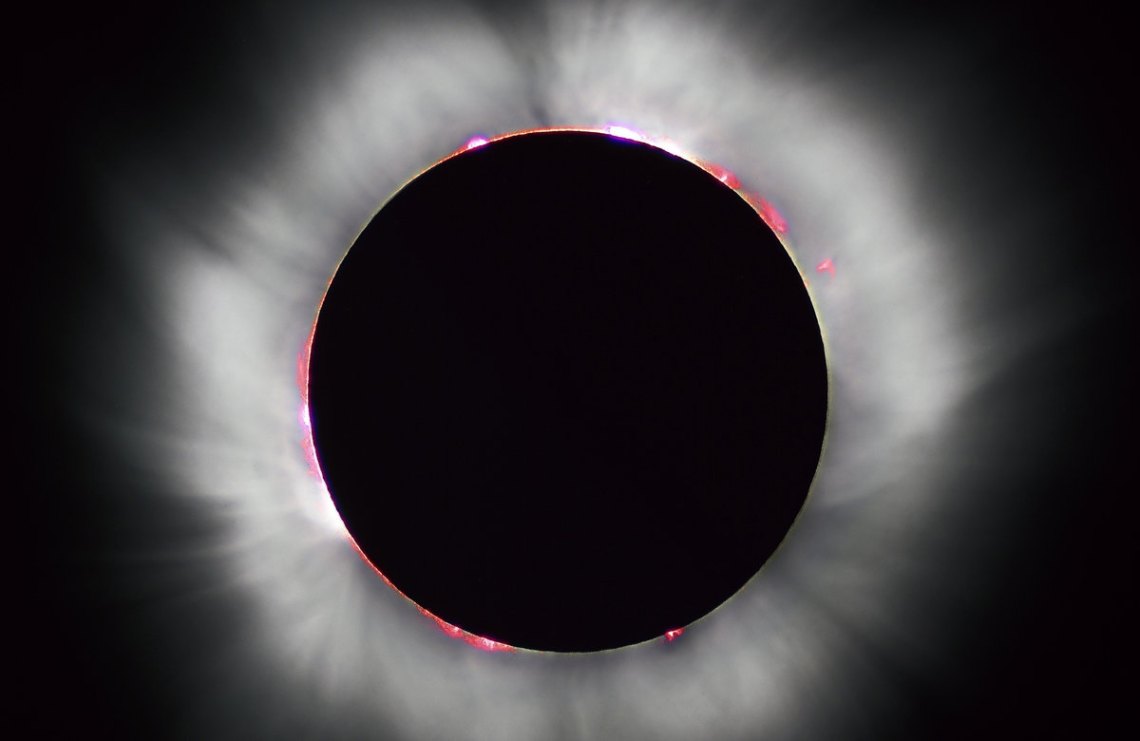The moon is 400 times smaller than the sun, and also just happens to be 400 times closer. So from the surface of the earth, the sun and moon appear to be the same size. This good luck is what makes the total eclipse possible: the sun blocked but the corona still visible.
Mere coincidence? The odds against it are astronomical. Even in our entire Milky Way galaxy of 100 billion stars, how many other perfect line-ups can there be?
This perfect sun-moon-Earth alignment is an extraordinary cosmic coincidence. The sun is 400 times larger than the moon, but it also happens to be 400 times farther away, which to the observer on the ground means they are almost identical in size. The match is so uncanny that on some occasions, the moon is at the farthest point of its slightly elongated orbit and fails to cover the sun fully, leaving a ring of sunlight. Such an annular eclipse is an impressive phenomenon in its own way but lacks the high drama of totality. In all the hundreds of billions of star systems of our Milky Way galaxy, few are likely to produce total solar eclipses like ours. It’s a coincidence not only of spatial relations but also of time and motion — heavenly bodies are in a constant state of change. https://www.nytimes.com/guides/science/how-to-watch-a-solar-eclipse
It’s a temporary arrangement. Hundreds of millions of years ago, the moon was closer and blocked too much of the sun for the corona to have been visible.
Final totality
Total solar eclipses are seen on Earth because of a fortuitous combination of circumstances. Even on Earth, the diversity of eclipses familiar to people today is a temporary (on a geological time scale) phenomenon. Hundreds of millions of years in the past, the Moon was closer to the Earth and therefore apparently larger, so every solar eclipse was total and there were no annular eclipses. Over a billion years in the future, the Moon will be too far away to fully occlude the Sun, and no total eclipses will occur.
Due to tidal acceleration, the orbit of the Moon around the Earth becomes about 2.2 cm more distant each year. It is estimated that, in slightly less than 1.4 billion years, the distance from the Earth to the Moon will have increased by 30,400 km. During that period, the apparent angular diameter of the Moon will decrease in size, meaning that it will no longer be able to completely cover the Sun’s disk as seen from the Earth. This will be true even when the Moon is at perigee, and the Earth at aphelion. Moreover, the Sun is increasing in diameter by about 5% per billion years.[40] Therefore, the last total solar eclipse on Earth will occur about six hundred million years from now. https://en.wikipedia.org/wiki/Solar_eclipse
There’s a problem with the moon.
The orbit of the moon is not stable. Because of tidal friction, the orbit of the Moon is steadily growing larger, so that the angular size of the moon from the Earth is shrinking. The moon’s orbit is increasing by about 3.8 cm (1.5 inches) per year. When the moon’s mean distance from Earth has increased an additional 14,600 miles, it will be too far away to completely cover the sun. This is true even at perigee when its disk will be smaller than the sun’s disk even when the sun is farthest from Earth at aphelion. At the current rate that the moon’s orbit is increasing, it will take over 600 million years for the last total solar eclipse to occur. A complicating factor is that the size of the sun itself will grow slightly during this time as it evolves as a star, which will act to make the time of “no more total eclipses” a bit sooner than 600 million years. https://eclipse2017.nasa.gov/faq
Enjoy while you can. We had only about 75% here at BQTA headquarters, but being in familiar surroundings enhanced the feeling of the eerie coldness of the air and the creepy frailty of the sunlight. I experienced a total eclipse only once, on Saturday March 7, 1970, when I drove from Alexandria Virginia out to the Eastern Shore, the part of the state lying east of Chesapeake Bay. Totality lasted about 78 seconds at about 1:37 pm. https://www.timeanddate.com/eclipse/map/1970-march-7
An eclipse is a glimpse into the eerie coldness of the unimaginably vast and inhospitable universe lying beyond the cozy sun and flower filled sliver we think of as nature.



Nice piece, Gregg. You’re both poet (“…a glimpse into the eerie coldness of the unimaginably vast and inhospitable universe …”) and philosopher!
I believe Lucretius got it right about 2,000 years ago when he concluded that “the patterns of order and disorder in the world are not the product of any divine scheme … No supreme choreographer planned their movements, and [the gods] did not have a meeting in which they decided what would go where”. The 400x coincidence is merely a temporary – albeit remarkable – “pattern of order”. Lucretius source: our friend Stephen Greenblatt in “Swerve”. (Reading “Swerve” I now realize how much we missed out having Adelman instead of Greenblatt freshman year.)
LikeLike
Thanks, Mark. Lucretius sounds like quite a guy. Well before his time. Nice to remember Greenblatt and Adelman.
My reference to intelligent design is tongue-in-cheek. ID does not come up in philosophy much, though Tom Nagel recently expressed interest in his book Mind and Cosmos, shocking everyone.
Some scientists do worry about creationism. Jerry Coyne’s book Why Evolution Is True is one long answer to creationism. Physicist Sean Carroll goes so far as to debate creationists live https://www.preposterousuniverse.com/blog/2014/02/27/godcosmology-debate-videos/ In The Big Picture p302, he discusses the “fine tuning” argument, which my point about the moon vaguely resembles. If any number of cosmological constants were even slightly different–things like the mass of an electron–planets could not form and life could not have emerged. Therefore, an intelligent God must have designed things this way.
LikeLike